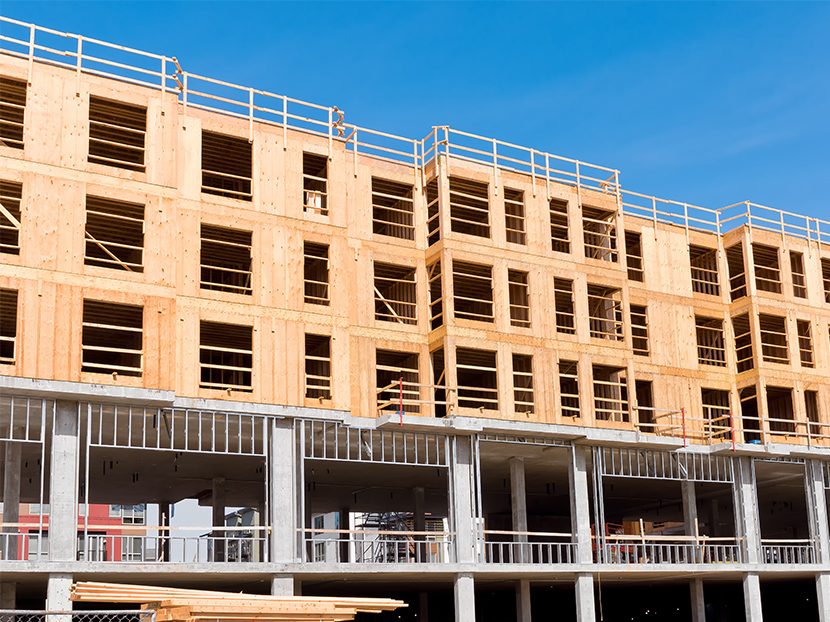Tall Timber Buildings
Combining prescriptive measures and performance-based design.

If you have been paying attention to the International Code Council (ICC) code development process for the 2021 International Building Code (IBC), you know the building industry is very much interested in whether new proposals permitting tall timber buildings will pass.
In the past decade, interest in taller wood buildings has increased. This can be attributed in part to the sustainability movement, support from the timber industry, and the development of mass timber building systems, such as, CLT.
What is CLT?
If you are anything like me, you probably googled the term CLT. I did, and here is what I found:
Cross-laminated timber (CLT) is a large-scale, prefabricated, solid engineered wood panel, consisting of several layers of kiln-dried lumber boards stacked in alternating directions, bonded with structural adhesives, and pressed to form a solid, straight, rectangular panel. CLT panels consist of an odd number of layers (usually, three to seven finished CLT panels are exceptionally stiff, strong, and stable, handling load transfer on all sides.
In addition to its load carrying qualities, there are several benefits being touted for its use, including aesthetic appeal and reduced construction costs.
Another benefit CLT panels are that they’re green. The timber is from sustainably managed forests (considered a renewable resource). Some argue that use of CLT will help mitigate climate change, since renewable forests represent a CO2 sink.
The most commonly cited disadvantage of CLT is with fire performance. Much of the focus in the building industry is on how to address the fire safety of tall timber buildings.
The drive for taller wood buildings has been largely led by our friends in Canada, seemingly because they have a lot of trees up there. With support from their timber industry, the Canadians are ahead of the U.S. in terms of bringing tall timber building provisions into their buildings codes.
Other countries including Australia, Norway, and the UK are constructing tall wood buildings using performance-based design methods. However, I would like focus on what is going on in Canada and U.S. as they seem to be addressing the tall building question with a reasoned approach of combining prescriptive measures and performance-based design. Clearly more conservative than these other countries, but in my view, more likely to establish building regulations that will result in safe tall wood buildings.
Like the current situation with the IBC, the 2010 (and prior editions) of the National Building Code of Canada (NBCC) permitted wood buildings up to four stories in height.
The Canadian provinces, which adopt the NBCC with amendments, have made amendments that are allowing wood buildings of greater height. The provinces of British Columbia (2009), Quebec (2013), and Ontario (2014) amended their building regulations to permit six-story wood buildings in residential, business, and personal (office) occupancies.
These amendments contain additional fire safety measures including sprinkler protection complying, fire area and height limitations, protections against exterior fire spread, protection of the means of egress, and fire apparatus access.
The NBCC later incorporated the provincial amendments permitting up to six-story buildings into its 2015 edition.
The next step for the Canadian provinces was to establish building directives that would permit even taller wood buildings.
In 2017 the province of Ontario published Ontario’s Tall Wood Building Reference A Technical Resource for Developing Alternative Solutions under Ontario’s Building Code.
This document provides guidance for the development of performance-based design solutions, called Alternative Solutions, in two categories: Mid-rise buildings 7 to 12 stories and high-rise buildings, which are taller than 12 stories.
When going the alternative solution route, compliance with the OBC must demonstrate that the alternative solution achieves at least the same level of performance as required by the acceptable solutions outlined in the building code.
The first and most critical alternative solution that must be addressed is that of combustible construction. The acceptable (prescriptive) solution for buildings seven or more stories in height is noncombustible construction. The most straightforward solution is to use encapsulation, “protecting” the mass timber construction with noncombustible or limited combustible materials such as gypsum board. Equivalence is demonstrated by showing that under conditions of a complete burnout, the combustible wood structure did not significantly contribute fuel to the fire. Thickness of encapsulation will be based on the protection time needed during that fire duration.
Of course, architects will naturally want to expose as much of the timber as possible for aesthetic reasons. Creative alternative solutions that expose the timber structure must be evaluated very carefully.
The Ontario Tall Building Reference identifies several “Common Tall Wood Building Fire Safety Strategies,” which include:
- Encapsulation
- Sprinkler Reliability
- Stair Pressurization
- Building Area
Quebec has also gone taller but has taken a much more prescriptive approach. This approach is contained in the publication Mass timber buildings of up to 12 storys, Directives and Explanatory Guide.
On the second page of this document we find the statement:
If designed and built in compliance with the conditions stipulated in Part 1 – Guidelines, and the technical specifications in Part 2 – Explanatory Guide of this document, these buildings are deemed to comply with the standards set out in the National Building Code 2010, amended for the province of Quebec.
As per the document title, it limits wood buildings to 12 stories in height. Prescriptive fire safety measures are included for:
- Basic Conditions
- Multiple Occupancies
- Fire-Resistance Rating
- Service Penetrations in Fire Separations
- Vertical Service Spaces and Stairwells
- Automatic Sprinkler System
- Environmental Separation
- Smoke Propagation
This guideline requires full encapsulation of the combustible structure.
Both the Ontario and Quebec guides address requirements for another very serious concern developing for tall wood buildings, fire safety during construction.
I did not see a similar document for tall wood buildings that applies to British Columbia. However, as part of a demonstration project supported by the 2013 National Resources Canada competition to promote wood products in Canada, the University of British Columbia recently completed construction of a 400-bed student dormitory. Known as the Brock Commons, it is 18 stories and 53 meters tall constructed using CLT. Fire safety features are similar to the guide for Ontario. The wood structure is fully encapsulated.
Now let us travel south and look at tall wood buildings in the U.S.
In the U.S., the IBC currently permits wood buildings that are provided with sprinkler protection to be up to four stories in height. This can be increased to five stories in the case where the four stories of combustible construction is placed on a Type IA fire resistive podium, separated by a 3-hour horizontal fire barrier, and provided the entire building stays within the allowable height permitted for the combustible building.
In 2016 the ICC established the Ad Hoc Committee on Tall Wood Buildings to develop code change proposals. Several code change proposals were submitted for the 2018 IBC, but they did not pass.
For the 2021 edition of the IBC and International Fire Code (IFC), the committee has submitted 14 proposals related to Tall Mass Timber buildings.
The package of proposals introduces three new Types of Construction to IBC Table 504.3, Type IV-A, Type IV-B, and Type IV-C.
The major differences between IV-A, IV-B and IV-C are in the required fire resistance rating of the structure and the amount of protection, i.e., encapsulation, of mass timber structure.
Type IV-A sprinklered buildings have 3-hour primary structural frame and bearing walls and 2-hour floors. All mass timber is encapsulated. For certain occupancies, Type IV-A buildings can have up to 18 stories and be up to 270 feet tall.
Type IV-B sprinklered buildings have 2-hour primary structural frame and bearing walls 2-hour floors. A percentage of the mass timber may be exposed (unprotected). For certain occupancies Type IV-B buildings can be up to 12 stories and 180 feet tall.
Type IV-C sprinklered buildings have 2-hour primary structural frame and bearing walls 2-hour floors. All of the mass timber may be exposed. Height and area limitations are similar to Type IV-HT (Heavy Timber).
The proposals include a requirement for Type IV-A and IV-B buildings more than 120 feet in height to have two water supply connections. The two connections must be located on different streets.
The provisions also include a requirement for sealant or adhesive at abutting edges and intersections of mass timber elements which are required to have a fire resistance rating, as well as only intersection with other building elements required to have a fire-resistance rating. Sealants and adhesives must pass prescribed standard test methods.
There is also a code change proposal to the IFC, which requires additional measures for fire safety during construction for Type IV-A, IV-B, and IV-C buildings.
The 2021 IBC proposals for Tall Timber Buildings put forth by Ad Hoc Committee on Tall Wood Buildings builds on the work of the Canadians and provides a solid prescriptive code basis for high-rise wood buildings up to 18 stories tall.
Should those proposal pass, what will be left for the performance-based design community is to come up with design solutions which allow more unprotected timber structure and taller buildings.
At the 12th International Performance Based-Code and Fire Safety Design Methods Conference recently held in Honolulu April 25 to 27, 2017 several presentation tracks were dedicated to use of CLT in high-rise buildings.
Included in the program, teams from four countries — Japan, New Zealand, Hong Kong, and the U.S. — presented a case study representing the design of a 40-story CLT high-rise in which the CLT was unprotected. Copies of the case-study reports are available at sfpe.org.
SFPE Notes:
Please mark your calendar. SFPE’s 2018 North America Conference & Expo will be held on Oct. 28 to Nov. 2, 2018 in Nashville, Tennessee. This annual event is frequently cited as the top source of the latest technical information on fire protection engineering issues and emerging trends, case studies, research, and codes and standards. There will also be several 1- to 3-day professional development seminars held in conjunction with the meeting. For more information see www.sfpe.org.





